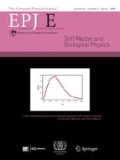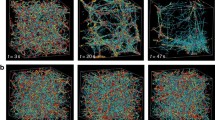Abstract.
It has been observed experimentally that the actin gel grown from spherical beads coated with polymerization enzymes spontaneously breaks the symmetry of its spherical shape, and yields a “comet” pushing the bead forward. We propose a mechano-chemical coupling mechanism for the initialization of this symmetry breaking. Key assumptions are that the dissociation of the gel takes place mostly in the region of the external surface, and that the rates of the dissociation depend on the tensile stress in the gel. We analyze a simplified two-dimensional model with a circular substrate. Our analysis shows that the symmetric steady state is always unstable against the inhomogeneous modulation of the thickness of the gel layer, for any radius of the circular substrate. We argue that this model represents the essential feature of three-dimensional systems for a certain range of characteristic lengths of the modulation. The characteristic time of the symmetry-breaking process in our model depends linearly on the radius of curvature of the substrate surface, which is consistent with experimental results, using spherical latex beads as substrate. Our analysis of the symmetry-breaking phenomenon demonstrates aspects of mechano-chemical couplings that should be working in vivo as well as in vitro.
Similar content being viewed by others
References
F. Gerbal, V. Laurent, A. Ott, P. Chaikin, J. Prost, Eur. Biophys. J. 29, 134 (2000).
J. Taunton, B.A. Rowning, M.L. Coughlin, M. Wu, R.T. Moon, T.J. Mitchison, C.A. Larabell, J. Cell Biol. 148, 519 (2000).
T.P. Loisel, R. Boujemaa, D. Pantaloni, M.F. Carlier, Nature 401, 613 (1999).
L.A. Cameron, M.J. Footer, A. van Oudenaarden, J.A. Theriot, Proc. Natl. Acad. Sci. U.S.A. 96, 4908 (1999).
V. Noireaux, R.M. Golsteyn, E. Friedrich, J. Prost, C. Antony, D. Louvard, C. Sykes, Biophys. J. 78, 1643 (2000).
D. Yarar, W. To, A. Abo, M.D. Welch, Curr. Biol. 9, 555 (1999).
A. Bernheim-Grosswasser, S. Wiesner, R.M. Goldsteyn, M.-F. Carlier, C. Sykes, Nature 417, 308 (2002).
S. Rafelski, P. Lauer, D. Portnoy, J. Theriot, http://cmgm.stanford.edu/theriot/movies.htm: Skidding moti-lity of mutant Listeria (2002).
A. van Oudenaarden, Julie A. Theriot, Nature Cell Biol. 1, 493 (1999).
A. Mogilner, G. Oster, Biophys. J. 84, 1591 (2003).
F. Gerbal, P. Chaikin, Y. Rabin, J. Prost, Biophys. J. 79, 2259 (2000).
L. Landau, E. Lifchitz, The Theory of Elasticity (Mir, Moscow, 1967).
K. Sekimoto, F. Jülicher, J. Prost, unpublished (2001).
K. Kassner, C. Misbah, J. Muller, J. Kappey, P. Kohlert, Phys. Rev. E 63, 036117 (2001). (The original literatures on the crystal growth related to the stress concentration, such as R.J. Asaro, W.A. Tiller, Metall. Trans. 3, 1789 (1972) and M.A. Grinfeld, Dokl. Akad. Nauk USSR 265, 836 (1982) are cited and described therein.)
F. Gerbal, V. Noireaux, C. Sykes, F. Jülicher, P. Chaikin, A. Ott, J. Prost, R.M. Golsteyn, E. Friederich, D. Louvard, V. Laurent, M.F. Carlier, Pramana 53, 155 (1999).
J. Prost, in Physics of Bio-molecules and Cells, Les Houches Session LXXV, 2-27 July 2001, edited by H. Flyvbjerg et al. , Les Houches Summer School Series, Vol. 75 (Springer, 2002).
M. Dogterom, B. Yurke, Science 278, 856 (1997).
J. Plastino, I. Lelidis, J. Prost, C. Sykes, Eur. Biophys. J. (published on line, 09 December, 2003); DOI: 10.1007/s00249-003-0370-3.
K. Tawada, K. Sekimoto, J. Theor. Biol. 150, 193 (1991).
P.A. Giardini, D.A. Fletcher, J.A. Theriot, Proc. Natl. Acad. Sci. U.S.A. 100, 6493 (2003).
A. Upadhyaya, J.R. Chabot, A. Andreeva, A. Samadani, A. van Oudenaarden, Proc. Natl. Acad. Sci. U.S.A. 100, 4521 (2003).
O. Campas, J.-F. Joanny, J. Prost, unpublished.
L.A. Cameron, T.M. Svitkina, D. Vignjevic, J.A. Theriot, G.G. Borisy, Curr. Biol. 11, 130 (2001).
Author information
Authors and Affiliations
Corresponding author
Additional information
Received: 16 July 2003, Published online: 23 March 2004
PACS:
87.17.Jj Cell locomotion; chemotaxis and related directed motion - 87.15.Rn Reactions and kinetics; polymerization - 62.40. + i Anelasticity, internal friction, stress relaxation, and mechanical resonances
K. Sekimoto: Present address: Université Louis Pasteur, 3 rue de l’Université, 67084 Strasbourg, France.
J. Prost: Also at ESPCI, 10 rue Vauquelin, 75231 Paris Cedex 05, France.
F. Jülicher: Present address: Max Planck Institut für Physik komplexer Systeme, Nöthnitzer Str. 38, 01187 Dresden, Germany.
A. Bernheim-Grosswasser: Present address: Chemical Engineering Department, Ben-Gurion University, P.O. Box 653, 84105 Beer-Sheva, Israel.
Rights and permissions
About this article
Cite this article
Sekimoto, K., Prost, J., Jülicher, F. et al. Role of tensile stress in actin gels and a symmetry-breaking instability. Eur. Phys. J. E 13, 247–259 (2004). https://doi.org/10.1140/epje/i2003-10073-y
Issue Date:
DOI: https://doi.org/10.1140/epje/i2003-10073-y




